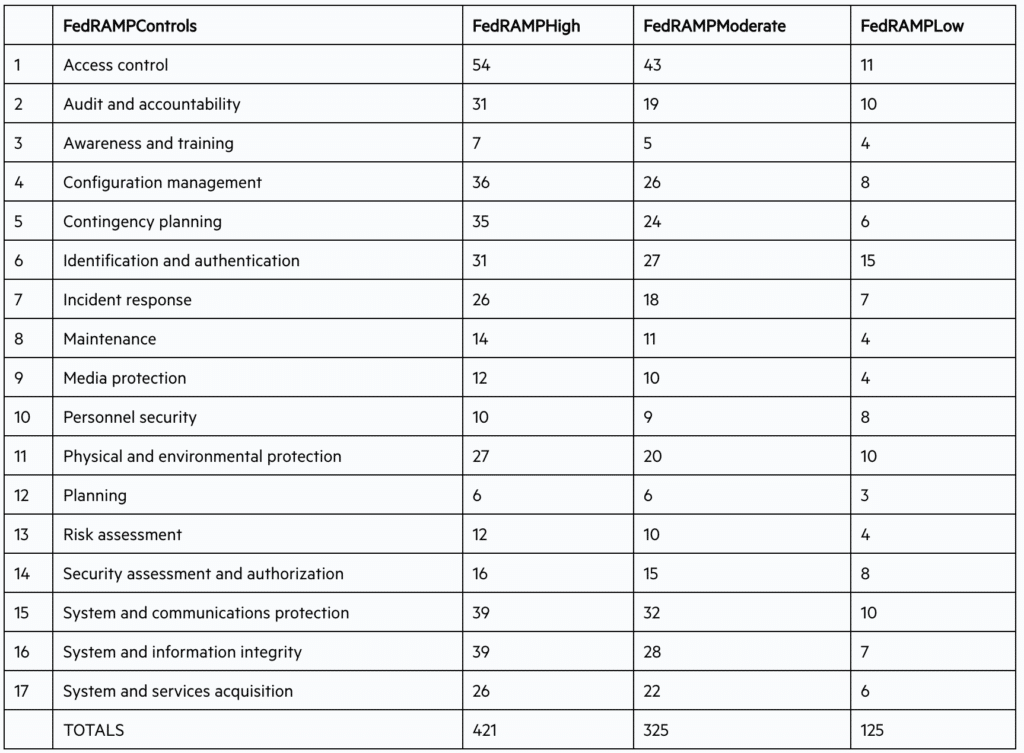In the government IT and cloud services world, FedRAMP is a term you’ve likely come across. But what exactly does it mean, and why is it so important? FedRAMP, short for Federal Risk and Authorization Management Program, is a government-wide program designed to standardize the way federal agencies assess, authorize, and monitor cloud services.
It provides a uniform approach to security assessment, authorization, and continuous monitoring for cloud products and services, ultimately ensuring federal data’s confidentiality, integrity, and availability.
In this blog post, we will dive into the details of FedRAMP, explaining the compliance and certification process and highlighting its significance in the government IT landscape. So, if you’re curious about FedRAMP and want better to understand its role in the world of cloud services, keep reading!

In this Guide:
What does it mean to be FedRAMP compliant?
Being FedRAMP compliant means that a company or organization has met the rigorous security standards and requirements set by the Federal Risk and Authorization Management Program (FedRAMP). FedRAMP is a government program that provides a standardized approach to security assessment, authorization, and continuous monitoring for cloud products and services.
To be FedRAMP compliant, a company must undergo a thorough security assessment and demonstrate their ability to meet a set of key security controls. These controls cover areas such as data protection, access controls, incident response, and vulnerability assessment, among others.
Achieving FedRAMP compliance is a significant undertaking that requires a comprehensive understanding of security best practices and the ability to implement and maintain a robust security program. It involves conducting a detailed assessment of a company’s systems and infrastructure, identifying potential vulnerabilities, and implementing controls and processes to mitigate those risks.
Being FedRAMP compliant offers several benefits for companies, especially those that provide cloud services to federal agencies. It allows them to demonstrate their commitment to the security and protection of sensitive data, which can help build trust with government customers. It also enables them to compete more effectively in the federal marketplace, as FedRAMP compliance is often a requirement for federal agencies when selecting cloud service providers.
Maintaining FedRAMP compliance is an ongoing process requiring regular monitoring, testing, and updating security controls. Companies must also undergo regular audits and assessments to ensure that they are maintaining compliance and addressing any changes or updates to the FedRAMP requirements.
FedRAMP Compliance Levels
Three levels of FedRAMP compliance are low, moderate, and high. Each level has its own set of security controls and requirements that must be met to achieve compliance. The level that your organization needs to achieve depends on the sensitivity of the federal data that you are storing or processing.Low Impact
The lowest level of FedRAMP compliance, known as low, is intended for cloud services that process federal data that is not considered sensitive or critical. These services have a lower risk profile and are subject to reduced security controls. This level of compliance is ideal for services that do not handle personally identifiable information (PII) or sensitive government data.Moderate Impact
The next level of FedRAMP compliance is moderate, which is required for cloud services that process sensitive federal data but not classified as critical. This level of compliance requires a more extensive set of security controls to protect the data and ensure its integrity, availability, and confidentiality. Moderate-level compliance is applicable to services that handle PII, financial data, and other sensitive information.High Impact
Finally, there is the high level of FedRAMP compliance, which is the most stringent and is reserved for cloud services that process federal data classified as critical. These services must adhere to the highest security controls to protect the most sensitive government data. Achieving high-level compliance requires a comprehensive and rigorous security program that meets the strictest standards. It’s important to note that achieving FedRAMP compliance requires more than just implementing the necessary security controls. It also involves a rigorous authorization process, including a security assessment conducted by an independent third-party assessor. This assessment evaluates the cloud service provider’s compliance with the FedRAMP requirements to ensure that the security controls are in place and functioning effectively.What Are FedRAMP Control Types?
Control families are groups of security requirements that are aligned with a specific set of controls and control enhancements. These control families are based on established security standards, guidelines, and practices such as the National Institute of Standards and Technology (NIST) Special Publication 800-53 and the Federal Information Processing Standards (FIPS) Publication 200. The purpose of control families is to provide a framework for managing and implementing security controls across different cloud services and platforms. By organizing controls into families, it makes it easier for cloud service providers (CSPs) and federal agencies to identify and address security requirements specific to their needs. FedRAMP currently consists of 17 control families, each with a specific focus area. Examples of control families include access control, risk assessment, incident response, and system and communications protection. Each control family includes a set of baseline security controls that must be implemented by CSPs seeking FedRAMP authorization.
Steps to Achieving FedRAMP Certification
To achieve FedRAMP certification, organizations must follow a series of steps outlined by the program. Here is a high-level overview of the process:- Understand the FedRAMP requirements: Before embarking on the certification process, it is important to understand the requirements and guidelines set forth by FedRAMP thoroughly. This includes understanding the security controls and documentation needed to meet the program’s standards.
- Conduct a pre-assessment: Before undergoing the formal assessment, organizations should conduct a thorough self-assessment to identify any potential gaps or weaknesses in their security controls. This pre-assessment will help determine areas that need improvement before the formal assessment.
- Select an accredited third-party assessment organization (3PAO): As part of the FedRAMP certification process, organizations must independently engage an accredited 3PAO to assess their cloud system. The 3PAO will evaluate the organization’s security controls and documentation to determine if it meets the FedRAMP requirements.
- Develop a System Security Plan (SSP): The SSP is a crucial document that outlines the security controls implemented by the organization. It includes information on how the controls are implemented, tested, and monitored. Developing a comprehensive and accurate SSP is essential for a successful certification.
- Undertake a formal assessment: Once the organization has completed the necessary preparations, it will undergo a formal assessment by the 3PAO. The 3PAO will evaluate the organization’s security controls and documentation during this assessment to ensure they meet the FedRAMP requirements.
- Address any findings: During the assessment, the 3PAO may identify areas of non-compliance or areas that need improvement. The organization must address these findings and make changes to meet the FedRAMP requirements.
- Submit the FedRAMP package: Once the organization has addressed any findings, it can submit its FedRAMP package for review. This package includes the SSP, audit reports, and other relevant documentation. The package is reviewed by the Joint Authorization Board (JAB) or the agency-specific authorizing official, depending on the path chosen by the organization.
- Continuous monitoring: FedRAMP certification is not a one-time event. Organizations must undergo continuous monitoring to ensure that their cloud system complies with the FedRAMP requirements. This includes regular audits, vulnerability scans, and other monitoring activities.
When Is FedRAMP Required?
In general, FedRAMP is required for any cloud service provider (CSP) that wants to work with federal agencies or handle federal data. This includes both government agencies themselves and private sector organizations that provide services to the government. The program ensures that these CSPs meet a certain level of security and compliance standards in order to protect sensitive government information.
There are different levels of FedRAMP authorization, including Low, Moderate, and High impact levels, depending on the sensitivity of the data being handled. The specific requirements for achieving FedRAMP compliance will vary based on the impact level, but they generally include implementing robust security controls, conducting regular audits and vulnerability assessments, and providing documentation to prove compliance.
It’s important to note that not all cloud service providers are required to obtain FedRAMP authorization. While it is mandatory for those working with federal agencies and handling federal data, it may be optional for organizations working with state or local government entities. Additionally, certain CSPs may choose to go through the FedRAMP process even if it is not required in order to demonstrate their commitment to security and gain a competitive advantage in the market.
How do you maintain FedRAMP compliance?
To maintain FedRAMP compliance, organizations must comprehensively understand the program’s requirements and implement appropriate controls and safeguards. This includes conducting regular risk assessments, performing vulnerability scans and penetration tests, and establishing incident response and recovery plans. Organizations must also ensure their personnel are properly trained and adhere to strict security protocols.
Regular monitoring and auditing of systems and processes are vital to ensure ongoing compliance. This includes regularly reviewing and updating security policies and procedures, conducting internal and external audits, and promptly addressing any identified vulnerabilities or non-compliance issues.
Organizations should also establish a close working relationship with FedRAMP officials and stay informed about any changes or updates to the program’s requirements. This can be achieved through regular communication and participation in relevant training and educational programs.
Furthermore, organizations should document and maintain thorough records of their compliance efforts, including any assessments, audits, and remediation activities. These records serve as evidence of compliance and can be useful during future audits or assessments.
FEDRamp FAQs
To put it simply, FedRAMP is the equivalent of a seal of approval for cloud service providers in the federal government. It is the highest level of security certification that a CSP can achieve, and it is recognized and accepted by all federal agencies.
In general, FedRAMP is required for any cloud service provider (CSP) that wants to work with federal agencies or handle federal data. This includes both government agencies themselves and private sector organizations that provide services to the government.
The Federal Risk and Authorization Management Program (FedRAMP) was created by the United States government to provide a standardized approach to security assessments, authorization, and continuous monitoring for cloud products and services used by federal agencies.
FedRAMP stands for the Federal Risk and Authorization Management Program. It is a government-wide program that provides a standardized approach to security assessment, authorization, and continuous monitoring for cloud products and services. While it is commonly referred to as a framework, it is more accurately described as a set of security requirements and guidelines.






